coolant DODGE CHARGER 2013 7.G User Guide
[x] Cancel search | Manufacturer: DODGE, Model Year: 2013, Model line: CHARGER, Model: DODGE CHARGER 2013 7.GPages: 132, PDF Size: 4.77 MB
Page 76 of 132
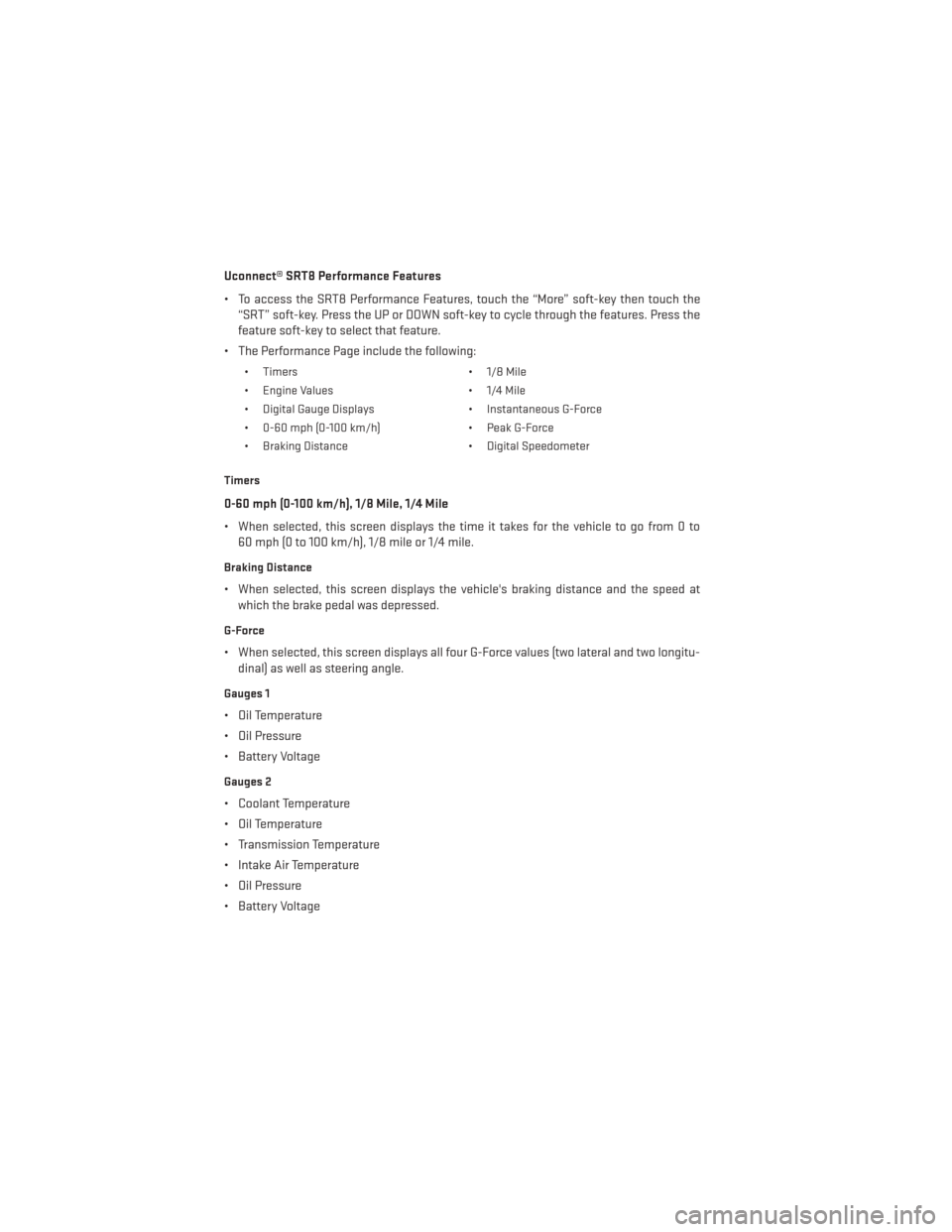
Uconnect® SRT8 Performance Features
• To access the SRT8 Performance Features, touch the “More” soft-key then touch the“SRT” soft-key. Press the UP or DOWN soft-key to cycle through the features. Press the
feature soft-key to select that feature.
• The Performance Page include the following:
• Timers • 1/8 Mile
• Engine Values • 1/4 Mile
• Digital Gauge Displays • Instantaneous G-Force
• 0-60 mph (0-100 km/h) • Peak G-Force
• Braking Distance • Digital Speedometer
Timers
0-60 mph (0-100 km/h), 1/8 Mile, 1/4 Mile
• When selected, this screen displays the time it takes for the vehicle to go from 0 to 60 mph (0 to 100 km/h), 1/8 mile or 1/4 mile.
Braking Distance
• When selected, this screen displays the vehicle's braking distance and the speed atwhich the brake pedal was depressed.
G-Force
• When selected, this screen displays all four G-Force values (two lateral and two longitu-dinal) as well as steering angle.
Gauges 1
• Oil Temperature
• Oil Pressure
• Battery Voltage
Gauges 2
• Coolant Temperature
• Oil Temperature
• Transmission Temperature
• Intake Air Temperature
• Oil Pressure
• Battery Voltage
SRT8
74
Page 79 of 132
•Your vehicle has also been equipped with a TPMS malfunction indicator to indicate when the
system is not operating properly. The TPMS malfunction indicator is combined with the low
tire pressure telltale. When the system detects a malfunction, the telltale will flash for
approximately one minute and then remain continuously illuminated. This sequence will
continue each time the vehicle is restarted as long as the malfunction exists.
•When the malfunction indicator is illuminated, the system may not be able to detect or
signal low tire pressure as intended. TPMS malfunctions may occur for a variety of reasons,
including the installation of replacement or alternate tires or wheels on the vehicle that
prevent the TPMS from functioning properly. Always check the TPMS malfunction telltale
after replacing one or more tires or wheels on your vehicle, to ensure that the replacement or
alternate tires and wheels allow the TPMS to continue to function properly.
NOTE:
Tire pressures change by approximately 1 psi (7 kPa) per 12° F (7° C) of air temperature
change. Keep this in mind when checking tire pressure inside a garage, especially in the
Winter. Example: If garage temperature is 68°F (20°C) and the outside temperature is 32°F
(0°C), then the cold tire inflation pressure should be increased by 3 psi (21 kPa), which equals
1 psi (7 kPa) for every 12°F (7°C) for this outside temperature condition.
CAUTION!
The TPMS has been optimized for the original equipment tires and wheels. TPMS
pressures and warning have been established for the tire size equipped on your vehicle.
Undesirable system operation or sensor damage may result when using replacement
equipment that is not of the same size, type, and/or style. Aftermarket wheels can cause
sensor damage. Do not use tire sealant from a can, or balance beads if your vehicle is
equipped with a TPMS, as damage to the sensors may result.
- Engine Temperature Warning Light
• This light warns of an overheated engine condition.
• If the light turns on or flashes continuously while driving, safely pull over and stop the vehicle. If the A/C system is on, turn it off. Also, shift the transmission into NEUTRAL and
idle the vehicle. If the temperature reading does not return to normal, turn the engine off
immediately.
• We recommend that you do not operate the vehicle or engine damage will occur. Have the vehicle serviced immediately.
WARNING!
A hot engine cooling system is dangerous. You or others could be badly burned by steam
or boiling coolant. You may want to call an authorized dealer for service if your vehicle
overheats.
WHAT TO DO IN EMERGENCIES
77
Page 82 of 132
Vehicles Not Equipped With Keyless Enter-N-Go™
• Turn the ignition switch to the ON/RUN position (Do not start the engine.)
• Fully depress the accelerator pedal, slowly, three times within 10 seconds.
• Turn the ignition switch to the OFF/LOCK position.
NOTE:
If the indicator message illuminates when you start the vehicle, the oil change indicator
system did not reset. If necessary, repeat this procedure.
IF YOUR ENGINE OVERHEATS
• In any of the following situations, you can reduce the potential for overheating by takingthe appropriate action.
• On the highways — slow down.
• In city traffic — while stopped, place the transmission in NEUTRAL, but do not increase engine idle speed.
NOTE:
There are steps that you can take to slow down an impending overheat condition:
• If your air conditioner (A/C) is on, turn it off. The A/C system adds heat to the engine cooling system and turning the A/C off can help remove this heat.
• You can also turn the temperature control to maximum heat, the mode control to floor and the blower control to high. This allows the heater core to act as a supplement to the
radiator and aids in removing heat from the engine cooling system.
CAUTION!
Driving with a hot cooling system could damage your vehicle. If the temperature gauge
reads HOT (H), pull over and stop the vehicle. Idle the vehicle with the air conditioner
turned off until the pointer drops back into the normal range. If the pointer remains on
HOT (H), and you hear continuous chimes, turn the engine off immediately, and call for
service.
WARNING!
You or others can be badly burned by hot engine coolant (antifreeze) or steam from your
radiator. If you see or hear steam coming from under the hood, do not open the hood until
the radiator has had time to cool. Never try to open a cooling system pressure cap when
the radiator or coolant bottle is hot.
WHAT TO DO IN EMERGENCIES
80
Page 107 of 132
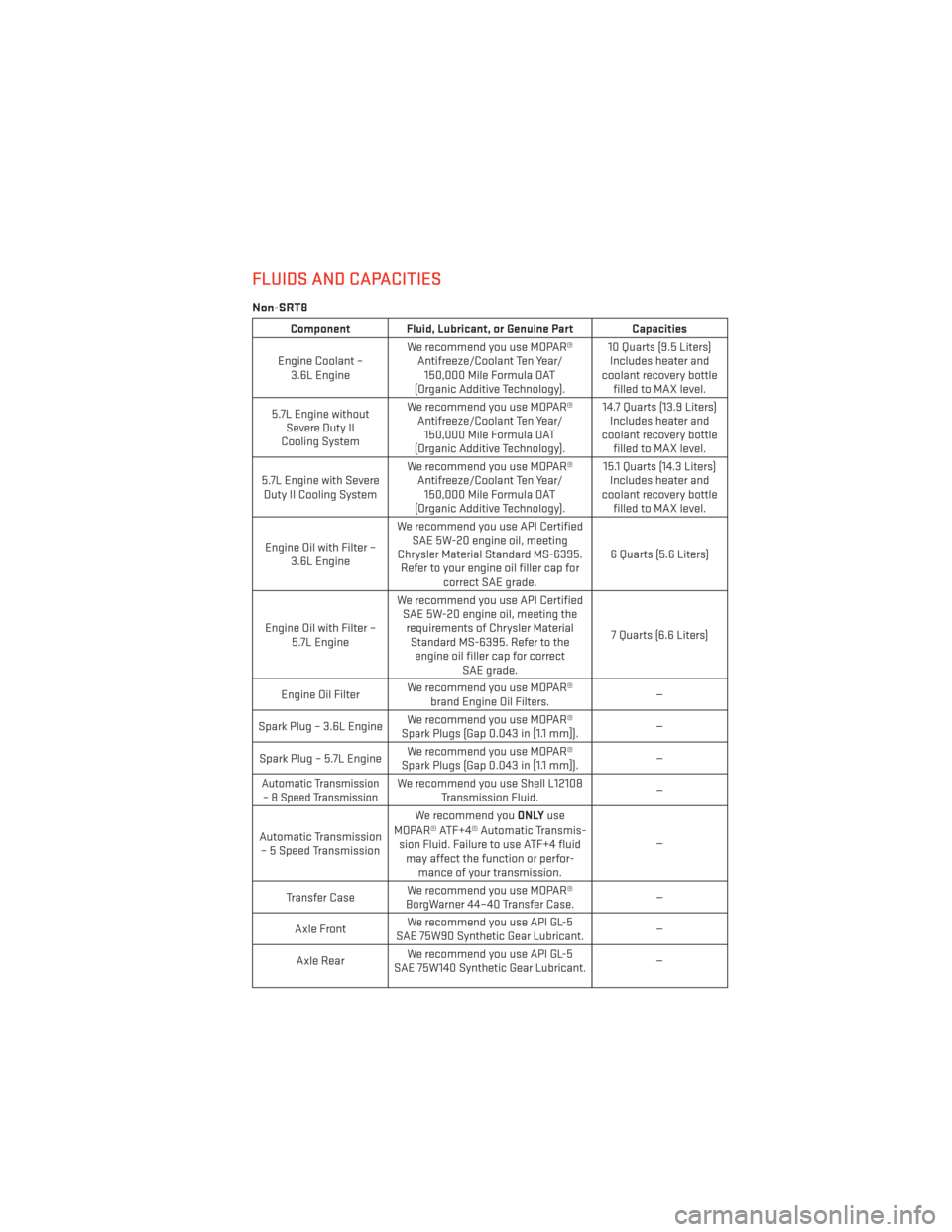
FLUIDS AND CAPACITIES
Non-SRT8
Component Fluid, Lubricant, or Genuine Part Capacities
Engine Coolant – 3.6L Engine We recommend you use MOPAR®
Antifreeze/Coolant Ten Year/150,000 Mile Formula OAT
(Organic Additive Technology). 10 Quarts (9.5 Liters)
Includes heater and
coolant recovery bottle filled to MAX level.
5.7L Engine without Severe Duty II
Cooling System We recommend you use MOPAR®
Antifreeze/Coolant Ten Year/150,000 Mile Formula OAT
(Organic Additive Technology). 14.7 Quarts (13.9 Liters)
Includes heater and
coolant recovery bottle filled to MAX level.
5.7L Engine with Severe Duty II Cooling System We recommend you use MOPAR®
Antifreeze/Coolant Ten Year/150,000 Mile Formula OAT
(Organic Additive Technology). 15.1 Quarts (14.3 Liters)
Includes heater and
coolant recovery bottle filled to MAX level.
Engine Oil with Filter – 3.6L Engine We recommend you use API Certified
SAE 5W-20 engine oil, meeting
Chrysler Material Standard MS-6395. Refer to your engine oil filler cap for correct SAE grade. 6 Quarts (5.6 Liters)
Engine Oil with Filter – 5.7L Engine We recommend you use API Certified
SAE 5W-20 engine oil, meeting therequirements of Chrysler Material Standard MS-6395. Refer to the engine oil filler cap for correct SAE grade. 7 Quarts (6.6 Liters)
Engine Oil Filter We recommend you use MOPAR®
brand Engine Oil Filters. —
Spark Plug – 3.6L Engine We recommend you use MOPAR®
Spark Plugs (Gap 0.043 in [1.1 mm]). —
Spark Plug – 5.7L Engine We recommend you use MOPAR®
Spark Plugs (Gap 0.043 in [1.1 mm]). —
Automatic Transmission
– 8 Speed TransmissionWe recommend you use Shell L12108 Transmission Fluid. —
Automatic Transmission – 5 Speed Transmission We recommend you
ONLYuse
MOPAR® ATF+4® Automatic Transmis- sion Fluid. Failure to use ATF+4 fluid may affect the function or perfor- mance of your transmission. —
Transfer Case We recommend you use MOPAR®
BorgWarner 44–40 Transfer Case. —
Axle Front We recommend you use API GL-5
SAE 75W90 Synthetic Gear Lubricant. —
Axle Rear We recommend you use API GL-5
SAE 75W140 Synthetic Gear Lubricant. —
MAINTAINING YOUR VEHICLE
105
Page 108 of 132
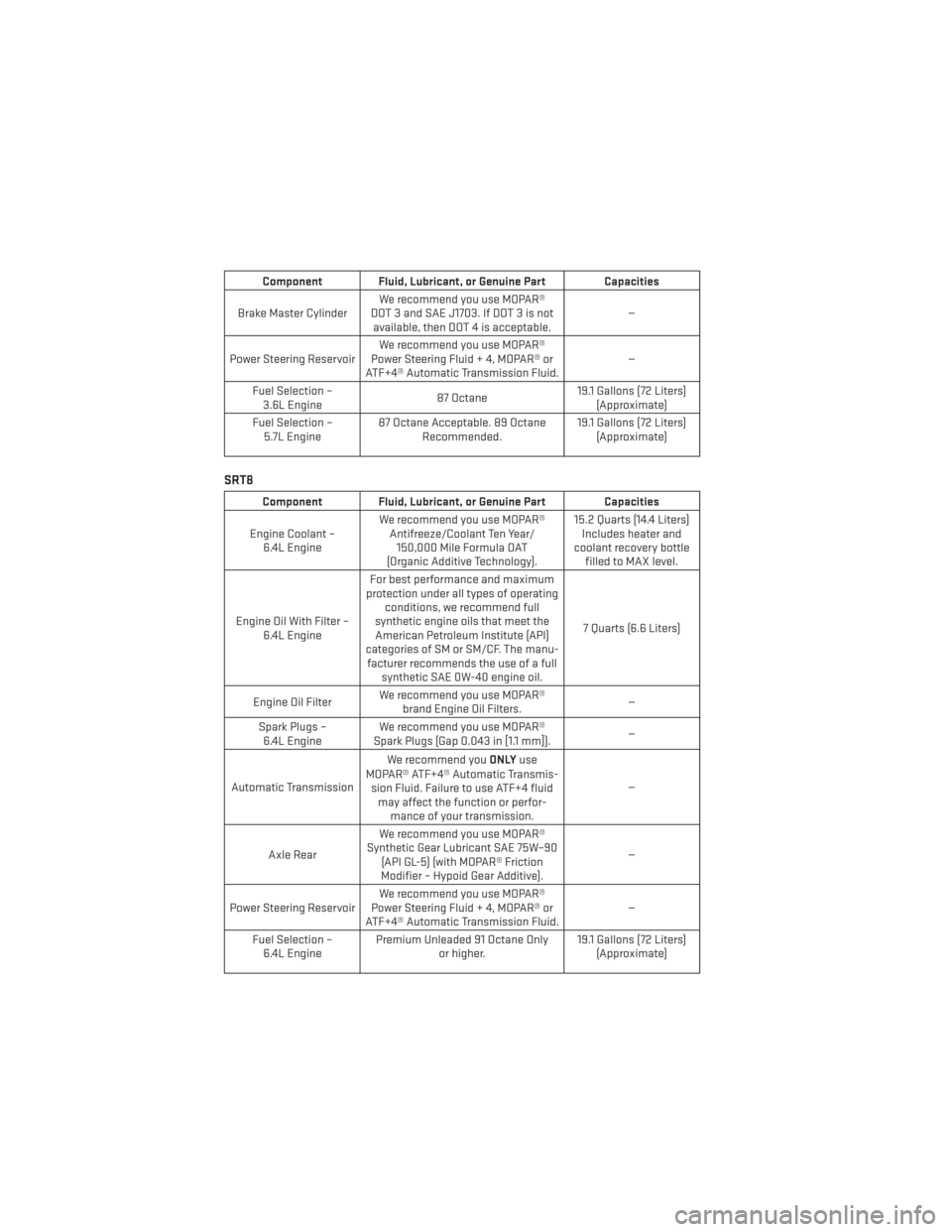
Component Fluid, Lubricant, or Genuine Part Capacities
Brake Master Cylinder We recommend you use MOPAR®
DOT 3 and SAE J1703. If DOT 3 is not available, then DOT 4 is acceptable. —
Power Steering Reservoir We recommend you use MOPAR®
Power Steering Fluid + 4, MOPAR® or
ATF+4® Automatic Transmission Fluid. —
Fuel Selection – 3.6L Engine 87 Octane19.1 Gallons (72 Liters)
(Approximate)
Fuel Selection – 5.7L Engine 87 Octane Acceptable. 89 Octane
Recommended. 19.1 Gallons (72 Liters)
(Approximate)
SRT8
Component Fluid, Lubricant, or Genuine Part Capacities
Engine Coolant – 6.4L Engine We recommend you use MOPAR®
Antifreeze/Coolant Ten Year/150,000 Mile Formula OAT
(Organic Additive Technology). 15.2 Quarts (14.4 Liters)
Includes heater and
coolant recovery bottle filled to MAX level.
Engine Oil With Filter – 6.4L Engine For best performance and maximum
protection under all types of operating conditions, we recommend full
synthetic engine oils that meet the American Petroleum Institute (API)
categories of SM or SM/CF. The manu- facturer recommends the use of a full synthetic SAE 0W-40 engine oil. 7 Quarts (6.6 Liters)
Engine Oil Filter We recommend you use MOPAR®
brand Engine Oil Filters. —
Spark Plugs – 6.4L Engine We recommend you use MOPAR®
Spark Plugs (Gap 0.043 in [1.1 mm]). —
Automatic Transmission We recommend you
ONLYuse
MOPAR® ATF+4® Automatic Transmis- sion Fluid. Failure to use ATF+4 fluid may affect the function or perfor- mance of your transmission. —
Axle Rear We recommend you use MOPAR®
Synthetic Gear Lubricant SAE 75W–90 (API GL-5) (with MOPAR® Friction
Modifier – Hypoid Gear Additive). —
Power Steering Reservoir We recommend you use MOPAR®
Power Steering Fluid + 4, MOPAR® or
ATF+4® Automatic Transmission Fluid. —
Fuel Selection – 6.4L Engine Premium Unleaded 91 Octane Only
or higher. 19.1 Gallons (72 Liters)
(Approximate)
MAINTAINING YOUR VEHICLE
106
Page 109 of 132

CAUTION!
• Mixing of engine coolant (antifreeze) other than specified Organic Additive Technol-ogy (OAT) engine coolant (antifreeze), may result in engine damage and may de-
crease corrosion protection. Organic Additive Technology (OAT) engine coolant is
different and should not be mixed with Hybrid Organic Additive Technology (HOAT)
engine coolant (antifreeze) or any “globally compatible” coolant (antifreeze). If a
non-OAT engine coolant (antifreeze) is introduced into the cooling system in an
emergency, it should be flushed with OAT coolant and replaced with the specified
OAT engine coolant (antifreeze) as soon as possible.
• Do not use water alone or alcohol-based engine coolant (antifreeze) products. Do not
use additional rust inhibitors or antirust products, as they may not be compatible
with the radiator engine coolant and may plug the radiator.
• This vehicle has not been designed for use with propylene glycol-based engine
coolant (antifreeze). Use of propylene glycol-based engine coolant (antifreeze) is not
recommended.
E-85 FLEXIBLE FUEL– (3.6L Engine Only)
• Refer to your Owner's Manual on the DVD for further details.
CAUTION!
Only vehicles with the E-85 fuel filler door label or a yellow gas cap can operate on E-85.
MAINTAINING YOUR VEHICLE
107
Page 110 of 132
MAINTENANCE SCHEDULE
Your vehicle is equipped with an automatic oil change indicator system. The oil change
indicator system will remind you that it is time to take your vehicle in for scheduled
maintenance.
Based on engine operation conditions, the oil change indicator message will illuminate.
This means that service is required for your vehicle. Operating conditions such as frequent
short-trips, trailer tow, extremely hot or cold ambient temperatures, and E85 fuel usage
will influence when the “Change Oil” or “Oil Change Required” message is displayed.
Severe Operating Conditions can cause the change oil message to illuminate as early as
3,500 miles (5,600 km) since last reset. Have your vehicle serviced as soon as possible,
within the next 500 miles (805 km).
On Electronic Vehicle Information Center (EVIC) equipped vehicles, “Oil Change Required”
will be displayed in the EVIC and a single chime will sound, indicating that an oil change is
necessary.
On Non-EVIC equipped vehicles, “Change Oil” will flash in the instrument cluster odometer
and a single chime will sound, indicating that an oil change is necessary.
Your authorized dealer will reset the oil change indicator message after completing the
scheduled oil change. If a scheduled oil change is performed by someone other than your
authorized dealer, the message can be reset by referring to the steps described under
“Electronic Vehicle Information Center (EVIC)/Oil Change Required” in “Understanding Your
Instrument Panel” or under “Instrument Cluster Description/Odometer/Trip Odometer” in
“Understanding Your Instrument Panel” for further information.
NOTE:
Under no circumstances should oil change intervals exceed 10,000 miles (16,000 km) or
twelve months, whichever comes first.
Once A Month Or Before A Long Trip:
• Check engine oil level
• Check windshield washer fluid level
• Check the tire inflation pressures and look for unusual wear or damage
• Check the fluid levels of the coolant reservoir, brake master cylinder, power steering andtransmission as needed
• Check function of all interior and exterior lights
MAINTAINING YOUR VEHICLE
108
Page 112 of 132
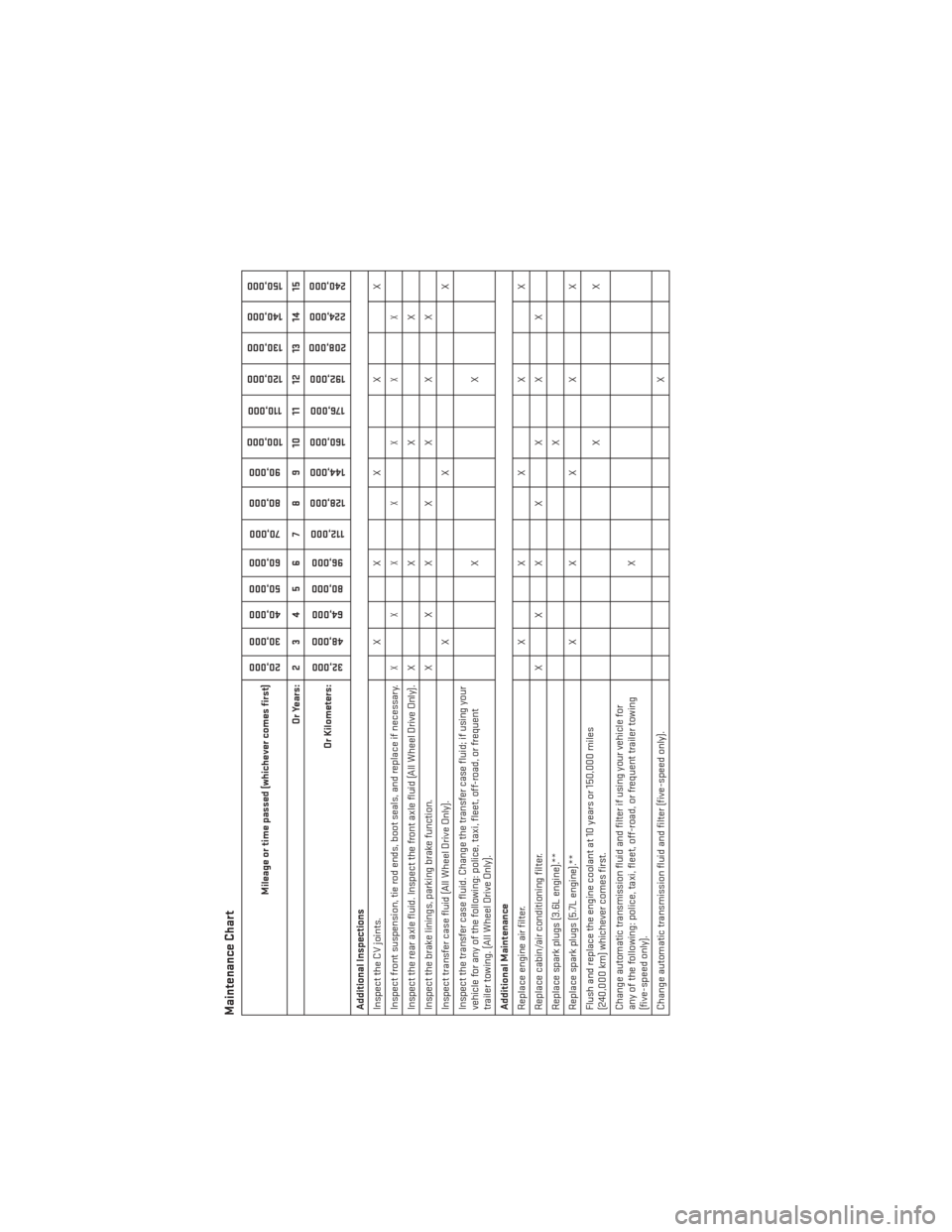
Maintenance Chart
Mileage or time passed (whichever comes first)
20,00030,000
40,000
50,000
60,000
70,000
80,000 90,000
100,000
110,000
120,000 130,000
140,000
150,000
Or Years: 2 3 4 5 6 7 8 9 10 11 12 13 14 15
Or Kilometers:
32,000
48,000
64,000
80,000
96,000
112,000
128,000 144,000
160,000
176,000
192,000
208,000 224,000
240,000
Additional Inspections
Inspect the CV joints. X X X X X
Inspect front suspension, tie rod ends, boot seals, and replace if necessary.
XXX X X X X
Inspect the rear axle fluid. Inspect the front axle fluid (All Wheel Drive Only). X XX X
Inspect the brake linings, parking brake function. X X X XXXX
Inspect transfer case fluid (All Wheel Drive Only). XX X
Inspect the transfer case fluid. Change the transfer case fluid; if using your
vehicle for any of the following: police, taxi, fleet, off-road, or frequent
trailer towing. (All Wheel Drive Only). XX
Additional Maintenance
Replace engine air filter. XX X XX
Replace cabin/air conditioning filter. X X X XXXX
Replace spark plugs (3.6L engine).** X
Replace spark plugs (5.7L engine).** XX X XX
Flush and replace the engine coolant at 10 years or 150,000 miles
(240,000 km) whichever comes first. XX
Change automatic transmission fluid and filter if using your vehicle for
any of the following: police, taxi, fleet, off-road, or frequent trailer towing
(five-speed only). X
Change automatic transmission fluid and filter (five-speed only). X
MAINTAINING YOUR VEHICLE
110
Page 115 of 132
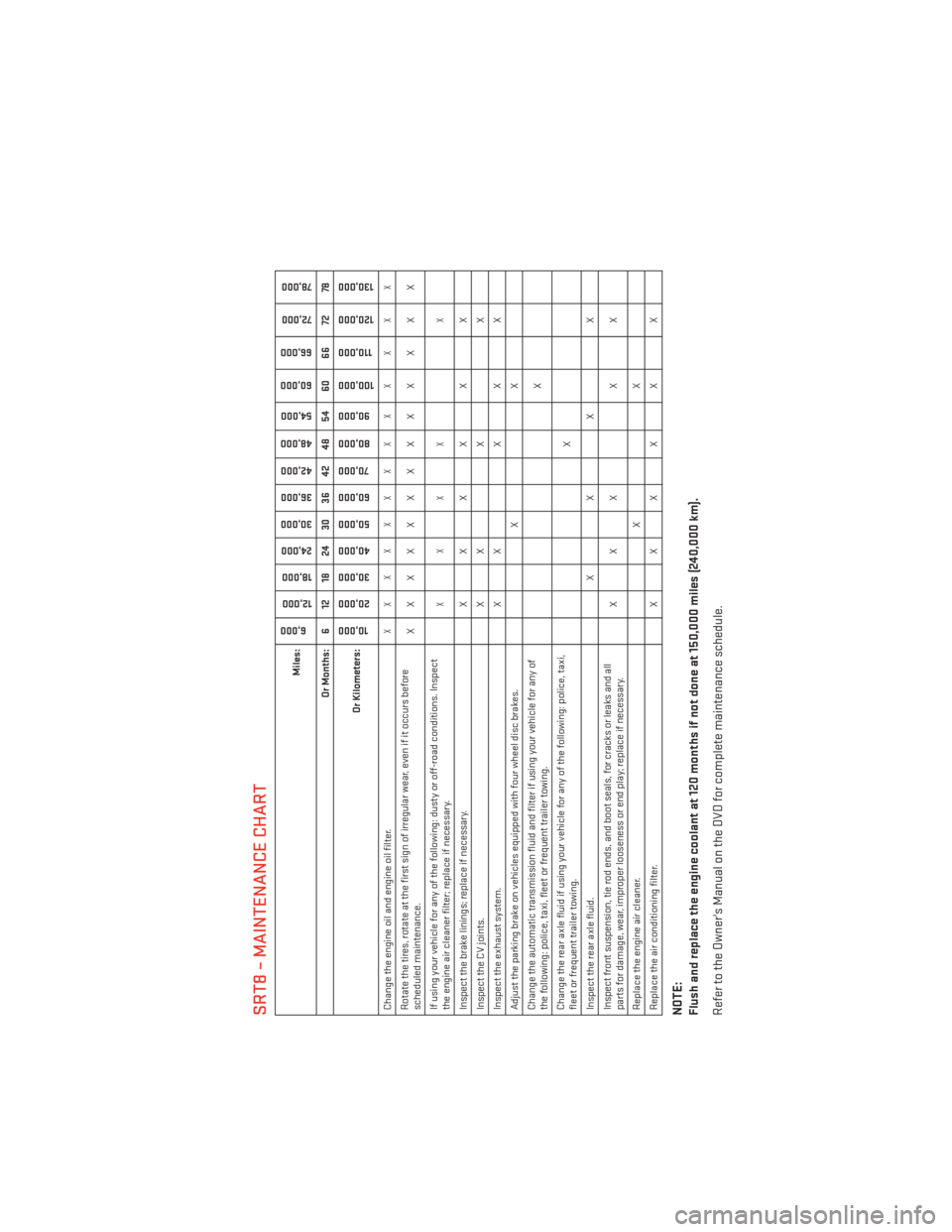
SRT8 – MAINTENANCE CHART
Miles:
6,000
12,000
18,000
24,000
30,000
36,000
42,000
48,000
54,000
60,000
66,000
72,000
78,000
Or Months: 6 12 18 24 30 36 42 48 54 60 66 72 78
Or Kilometers:
10,000
20,000 30,000
40,000
50,000
60,000 70,000
80,000
90,000
100,000
110,000
120,000 130,000
Change the engine oil and engine oil filter.
XXXXXXX X X X X X X
Rotate the tires, rotate at the first sign of irregular wear, even if it occurs before
scheduled maintenance. XXXXXXX X X X X X X
If using your vehicle for any of the following: dusty or off-road conditions. Inspect
the engine air cleaner filter; replace if necessary.
XXX X X
Inspect the brake linings; replace if necessary. X X X X XX
Inspect the CV joints. X XXX
Inspect the exhaust system. X XX XX
Adjust the parking brake on vehicles equipped with four wheel disc brakes. XX
Change the automatic transmission fluid and filter if using your vehicle for any of
the following: police, taxi, fleet or frequent trailer towing. X
Change the rear axle fluid if using your vehicle for any of the following: police, taxi,
fleet or frequent trailer towing. X
Inspect the rear axle fluid. XX X X
Inspect front suspension, tie rod ends, and boot seals, for cracks or leaks and all
parts for damage, wear, improper looseness or end play; replace if necessary. XXX
X X
Replace the engine air cleaner. XX
Replace the air conditioning filter. X X X X XXNOTE:
Flush and replace the engine coolant at 120 months if not done at 150,000 miles (240,000 km).
Refer to the Owner's Manual on the DVD for complete maintenance schedule.
MAINTAINING YOUR VEHICLE
113
Page 126 of 132
Adaptive Cruise Control (ACC)(Cruise Control) ............27
AdjustablePedals.............21
Airbag ...................13
Arming Theft System (Security Alarm). .12
Automatic Headlights ..........25
Automatic Temperature Control (ATC)...34
Automatic Transmission Autostick ...............71
Fluid Type ..............105
Autostick .................71
AxleFluid ................105
Belts, Seat .................13
BrakeFluid................105
Break-In Recommendations, New Vehicle ..............23
Bulb Replacement ............120
Calibration, Compass ...........64
Change Oil Indicator ...........79
ChangingAFlatTire ...........81
Child Restraint ..............14
Child Restraint Tether Anchors ......15
Compass Calibration ...........64
Cooling System Coolant Capacity ..........105
Cruise Control (Speed Control) ......26
Cruise Light ................26
Cupholders
Heated/Cooled (Beverage Holder)..20
Customer Assistance ..........121
Customer Programmable Features. . . .65
Defects, Reporting ............122
DimmerControl..............25
Dimmer Switch, Headlight ........25
Disarming, Theft System .........12
ECO....................64
Electronics Your Vehicle's Sound System ....38
Electronic Speed Control (Cruise Control) ............26
Electronic Vehicle Information Center(EVIC) ...........63,64 Emergency, In Case of
Brake Warning Light .........78
Jacking ................81
Overheating .............80
Emergency Key ..............8
Engine Break-In Recommendations .....23
Compartment ........... .102
Oil Selection .............105
Overheating .............80
Starting ................11
Stopping ...............11
Event Data Recorder ...........98
Exterior Lights ..............120
Flat Tire Changing .............81
Fluid Capacities .............105
Fluids ..................105
FogLights ................25
Freeing A Stuck Vehicle ..........97
Front Heated Seats ............19
Fuel Filler Door Emergency Release . . .100
Filler Door (Gas Cap) ........100
Specifications ............105
Fuse .................. .115
Fuses ...................115
Garage Door Opener (HomeLink®) ....66
Headlights Automatic ..............25
Dimmer Switch ............25
HighBeam ..............25
Heated Mirrors ..............35
Heated Seats ...............19
High Beam/Low Beam Select (Dimmer) Switch ............25
HomeLink® (Garage Door Opener) ....66
Hood Release ...............99
Instrument Cluster Indicators ...............7
Intermittent Wipers (Delay Wipers) ....24
Introduction ................2
iPod®/USB/MP3 Control .........54
Bluetooth Streaming Audio .....55
INDEX
124